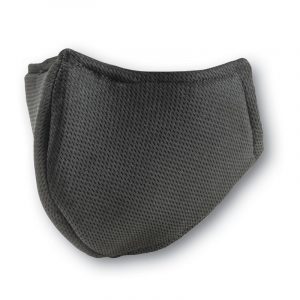 University study showed face mask made using ProCool® and Zorb 3D fabrics from AKAS was highly effective in blocking transmission of virus-like particles.
University study showed face mask made using ProCool® and Zorb 3D fabrics from AKAS was highly effective in blocking transmission of virus-like particles.
By Rachael S. Davis,Executive Editor
When it comes to face mask design, there are many attributes that are important. The mask must be large enough and fit well, it must provide adequate filtration, and it must be breathable and comfortable against the skin. Fabric treatments to protect from bacteria and viruses also may be considered.
AKAS Textiles and Laminations — a family-owned high-performance fabric company based in Bensalem, Pa. —took all of these design attributes into consideration when it shared suggestions with customers about how to select AKAS fabrics for the inner, middle filtration and outer layers of a face mask. The company also made some prototype masks that it donated to a local hospital and shared with people in its community.
The company was surprised to recently discover that a study — “Effectiveness of Common Fabrics to Block Aqueous Aerosols of Virus-Like Nanoparticles” — performed at Northeastern University in the Department of Chemical Engineering and published in the peer-reviewed scientific journal ACS Nano, found a mask made using AKAS fabrics offered the best filtration properties in an aqueous media under positive pressure of 20 kiloPascals simulating a sneeze or cough. The study examined some 70 masks made using common fabric combinations and in different mask styles, including the N95 respirator mask, to determine each mask’s ability to block the transmission of virus-like particles.
The AKAS mask tested features inner and outer layers of ProCool® Performance Fabric and a middle filtration layer of Zorb® 3D Stay Dry Dimple fabric. According to the study, the combination of these two fabrics tested 72-percent more effective than the N95 respirator.
The ProCool variant featured in the mask is a two-sided inter-knitted fabric with one-way wicking properties. The Zorb 3D Stay Dry Dimple fabric is an engineered design featuring a wicking layer on top of a dense cellulosic core.
For the face mask applications, AKAS also created a new Zorb 3D variant withthe addition of an antimicrobial Silvadur™ treatment. AKAS has applied for patents for the ProCool and Zorb fabrics as well as its mask design.
Archana Sharma, CEO of AKAS and affiliated company Wazoodle, said: “I looked at our entire fabric range before honing in on this combination. Before that, I studied the construction, materials and efficiencies of cloth masks, surgical masks and N95s in detail. I thought if we could harness fabric properties — hydrophobic fibers with hydrophilic, knit structures that formed multiple barriers, and a convoluted maze to stop, trap and hold aqueous aerosols, we might have something that worked. And by adding an antimicrobial we could expect the trapped microbes to be continuously destroyed, preventing build up.”
Sharma notes the company made prototypes and tested them in-house for breathability and design, but made no claims because there was no official test data. AKAS was unaware of the Northeastern study and only learned its mask — shared by a local hospital — had been tested when the results were published.
“I was delighted that our U.S.-based fabrics were determined to be the best combination of fabrics tested in the study,” Sharma said. “The results validated our theory and expectations.”
The prototype mask is washable, as well as comfortable despite its bulk, according to Sharma. The company plans to engineer a lighter version in the future. AKAS still does not make any claims about its prototypes, but believes it is on the right path and hopes to offer wholesale quantities of masks soon.
For more information aboutAKAS fabrics for face mask production including ProCool® Performance Fabric and Zorb® 3D Stay Dry Dimple fabric, contact President Sidharth Sharma +215-244-2589; info@akasllc.com.
July/August 2020




